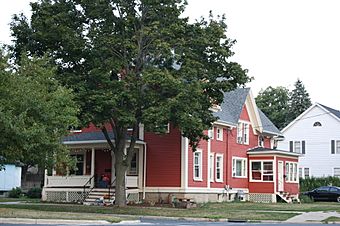South Dickason Boulevard Residential Historic District facts for kids
Quick facts for kids |
|
|
South Dickason Boulevard Residential Historic District
|
|

A house within the district.
|
|
| Location | Roughly along S. Dickason Blvd., from W. School St. to W. Harrison, also along S. Ludington St., Columbus, Wisconsin |
|---|---|
| Area | 6 acres (2.4 ha) |
| NRHP reference No. | 99000240 |
| Added to NRHP | March 4, 1999 |
The South Dickason Boulevard Residential Historic District is a special area in Columbus, Wisconsin. It is known for its beautiful old houses. This district helps us remember the history and different building styles of the past.
What is the South Dickason Boulevard Historic District?
This historic district is a neighborhood with several important old homes. These houses show different types of architecture from many years ago. The district covers about 6 acres of land. It was officially recognized as a historic place in 1998. The next year, in 1999, it was added to the National Register of Historic Places. This means it is a very important historical site in the United States.
What Kind of Houses Can You See?
The district features several unique houses, each built in a different style. These homes show how architecture changed over time.
The Long/Baker House: A Changing Style
One house in the district is the Long/Baker house. It was built in the early 1860s. Originally, it was in the Greek Revival style. This style often uses columns and looks like ancient Greek temples. Later, the house was updated to the Queen Anne style. This style is known for its towers, turrets, and decorative details.
The Manning House: Italianate Beauty
Another home is the Manning house, built in 1868. This house is a great example of Italianate architecture. Italianate homes often have low-pitched roofs, wide eaves, and tall, narrow windows. They look a bit like Italian villas.
The Wright House: Classic Queen Anne
The Wright house, built in 1900, is a clear example of the Queen Anne style. This popular style from the late 1800s and early 1900s is very decorative. It often includes different textures, colors, and shapes on the outside.
The Fritz House: Craftsman Style
Built in 1921, the Fritz house shows the Craftsman style. Craftsman homes focus on natural materials and handmade details. They often have low-pitched roofs, wide porches, and exposed wooden beams. This style emphasizes simplicity and quality craftsmanship.
The Albrecht House: Norman Revival
The Albrecht house, built in 1930, is in the Norman Revival style. This style takes inspiration from medieval French architecture. It often features stone walls, round towers, and steep roofs. It gives the house a castle-like appearance.
Why Are Historic Districts Important?
Historic districts like this one help us learn about the past. They preserve old buildings that tell stories about how people lived and what was important to them. By protecting these areas, we can keep history alive for future generations. It also helps people understand different architectural styles and how they developed.

